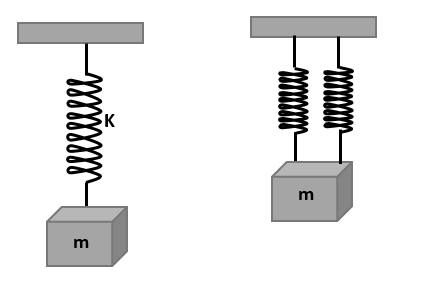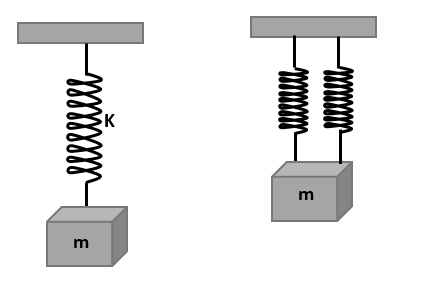
A mass m performs oscillations of period T when hanged by spring of force constant K. If spring is cut in two parts and arranged in parallel and same mass is oscillated by them, then the new time period will be

Figure: The spring-mass system
A. \[2T\]
B. \[T\]
C. \[\dfrac{T}{{\sqrt 2 }}\]
D. \[\dfrac{T}{2}\]
Answer
219.3k+ views
Hint: The spring constant of the spring is inversely proportional to the length of the spring. If the same spring is divided into smaller spring lengths then the resulting spring will have more stiffness than the original one. We find the equivalent stiffness of the combination then use it in the formula of the period of spring-mass system.
Formula used:
\[T = 2\pi \sqrt {\dfrac{m}{k}} \]
Where T is the period, k is the spring constant and m is the mass of the block.
Complete step by step solution:

Figure: The spring-mass system
For the initial case, using period formula,
\[T = 2\pi \sqrt {\dfrac{m}{k}} \]
As we know that the spring constant of the spring is inversely proportional to the length of the spring, so when the spring is divided into two equal parts, then the spring constant of each equal parts will be twice of the original spring.
It is given that the spring constant of original spring is k, so the spring constant of each part will be 2k. Then, the equivalent spring constant in parallel is,
\[{K_{eq}} = 2k + 2k = 4k\]
So, the final period of the system will be,
\[{T_2} = 2\pi \sqrt {\dfrac{m}{{4K}}} \]
\[{T_2} = \dfrac{1}{2}\left( {2\pi \sqrt {\dfrac{m}{k}} } \right)\]
On dividing the expression for the periods, we get
\[\dfrac{T}{{{T_2}}} = \dfrac{{\left( {2\pi \sqrt {\dfrac{m}{k}} } \right)}}{{\dfrac{1}{2}\left( {2\pi \sqrt {\dfrac{m}{k}} } \right)}}\]
\[\dfrac{T}{{{T_2}}} = 2\]
\[{T_2} = \dfrac{T}{2}\]
So, the period of the new spring-mass system is half of the initial period.
Therefore, the correct option is (D).
Note: We should assume that the spring’s mass is negligible in relative to the mass suspended through the spring. Otherwise the motion of the block will not be perfect simple harmonic.
Formula used:
\[T = 2\pi \sqrt {\dfrac{m}{k}} \]
Where T is the period, k is the spring constant and m is the mass of the block.
Complete step by step solution:

Figure: The spring-mass system
For the initial case, using period formula,
\[T = 2\pi \sqrt {\dfrac{m}{k}} \]
As we know that the spring constant of the spring is inversely proportional to the length of the spring, so when the spring is divided into two equal parts, then the spring constant of each equal parts will be twice of the original spring.
It is given that the spring constant of original spring is k, so the spring constant of each part will be 2k. Then, the equivalent spring constant in parallel is,
\[{K_{eq}} = 2k + 2k = 4k\]
So, the final period of the system will be,
\[{T_2} = 2\pi \sqrt {\dfrac{m}{{4K}}} \]
\[{T_2} = \dfrac{1}{2}\left( {2\pi \sqrt {\dfrac{m}{k}} } \right)\]
On dividing the expression for the periods, we get
\[\dfrac{T}{{{T_2}}} = \dfrac{{\left( {2\pi \sqrt {\dfrac{m}{k}} } \right)}}{{\dfrac{1}{2}\left( {2\pi \sqrt {\dfrac{m}{k}} } \right)}}\]
\[\dfrac{T}{{{T_2}}} = 2\]
\[{T_2} = \dfrac{T}{2}\]
So, the period of the new spring-mass system is half of the initial period.
Therefore, the correct option is (D).
Note: We should assume that the spring’s mass is negligible in relative to the mass suspended through the spring. Otherwise the motion of the block will not be perfect simple harmonic.
Recently Updated Pages
Two discs which are rotating about their respective class 11 physics JEE_Main

A ladder rests against a frictionless vertical wall class 11 physics JEE_Main

Two simple pendulums of lengths 1 m and 16 m respectively class 11 physics JEE_Main

The slopes of isothermal and adiabatic curves are related class 11 physics JEE_Main

A trolly falling freely on an inclined plane as shown class 11 physics JEE_Main

The masses M1 and M2M2 M1 are released from rest Using class 11 physics JEE_Main

Trending doubts
JEE Main 2026: Application Form Open, Exam Dates, Syllabus, Eligibility & Question Papers

Understanding Uniform Acceleration in Physics

Derivation of Equation of Trajectory Explained for Students

Hybridisation in Chemistry – Concept, Types & Applications

Understanding the Angle of Deviation in a Prism

Understanding Collisions: Types and Examples for Students

Other Pages
JEE Advanced Marks vs Ranks 2025: Understanding Category-wise Qualifying Marks and Previous Year Cut-offs

Units And Measurements Class 11 Physics Chapter 1 CBSE Notes - 2025-26

NCERT Solutions For Class 11 Physics Chapter 8 Mechanical Properties Of Solids

Motion in a Straight Line Class 11 Physics Chapter 2 CBSE Notes - 2025-26

NCERT Solutions for Class 11 Physics Chapter 7 Gravitation 2025-26

Understanding Atomic Structure for Beginners




